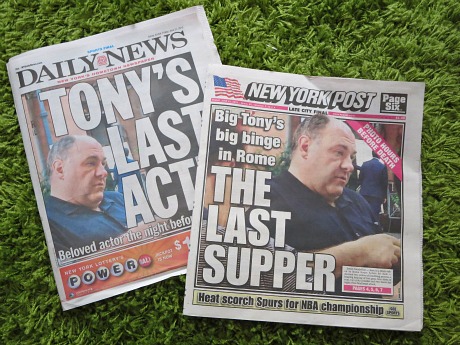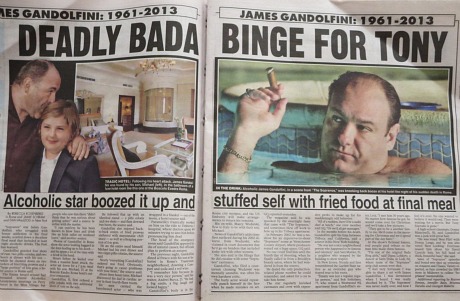What I strongly presumed when I read yesterday’s sad, tragic news about James Gandolfini but which I didn’t give voice to (partly because it’s better to wait two or three days and partly out of fear of being ripped to shreds by Glenn Kenny and HE’s sensitivity police), N.Y. Daily News and N.Y. Post writers have now reported. How dare they print observations and allegations that suggest Gandolfini might be with us today if he’d been a little smarter about certain tendencies? Don’t they realize how heartless stories like this are? Don’t they understand the basic rules when someone famous dies? One, during the first 24 to 48 hours after their passing never touch upon any apparent or probable reasons why and two, focus only on how kind, gifted, beloved and gracious they were, and how we’re now all poorer for their absence.


I couldn’t go there when Bob Clark died but I did yesterday because the character and story of Tony Soprano hit me right smack dab where I lived. Gandolfini and Sopranos creator David Chase created a dark American ethos that reflected a modern and very common existential reality. Almost everyone saw themselves in this guy, or at the very least understood that he was going through the same crap that anyone with any kind of business or familiar burden in 21st Century America understood all too well.
By the way I love Lee Siegel‘s N.Y. Times op-ed about Gandolfini, which offers an fascinating thought about how Tony Soprano paved the way for New Jersey Governor Chris Christie:
“Without Mr. Gandolfini’s six-season tour de force as Tony Soprano, I don’t think the state would have been ready for big, blustery Chris Christie.
“As district attorney, [Christie] came across as too darn mean, a dream-trampling Manhattan A-type, not a bowed-but-unbroken Garden State underdog. But Mr. Gandolfini’s uncanny habitation of Tony provided the key to Christie’s character: schooled in Tony’s fears and insecurities, New Jerseyans could see the wary uncertainty in Mr. Christie’s eyes. Tutored by weak Tony’s crumbling largeness, we understood the wound beneath Mr. Christie’s potentially fatal bulk.
“Watching television images of the emotionally devastated Mr. Christie survey the Jersey Shore after it had been ravaged by Hurricane Sandy, you realized that the governor’s success lay in the Gandolfini-shaped perception that though he might bellow like a baritone, somewhere deep inside he wept like a soprano.”
If Christie doesn’t see Gandolfini’s passing as a wake-up call about his eating habits, he’ll never get the message.
This is good also: “Mr. Gandolfini also had a purchase on the American psyche far beyond the Garden State’s borders. The tremors that grew into full-scale convulsions in 2008 — class divisions, social anomie, economic panic — were already being felt, under the media radar, by many Americans around the time The Sopranos had its premiere on HBO in January 1999. The middle class was being assaulted from all sides by a changing economy, outsourced jobs, soaring prices. People began to grow more explicit in the pursuit of their self-interest. Employers broke the social contract with their employees. Employees had to scramble over their co-workers to keep their jobs.
“No wonder people were glued to Tony Soprano.
“They watched him, this monster with a tender side, in a trance of horrified recognition. As our social life became reduced to considerations of the bottom line, the violence and humiliation Tony wrought in the name of ‘just business’ — to quote the famous line from The Godfather, a movie that haunts Tony’s imagination — spoke to Americans in upheaval. Here was a sociopath who now seemed like the guy next door, a Ward Cleaver for the 21st century.
“Mr. Gandolfini’s artistic triumph was to create an asphalt monster with a tender, suburban side, to conjure up a gangster whose exposure of his own brutality offered a relief from our moment of increasingly impersonal social relations.”









